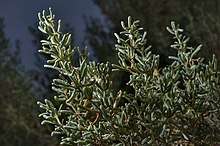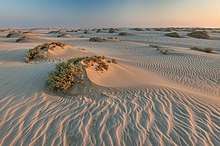Seidlitzia rosmarinus
Seidlitzia rosmarinus is a perennial-green desert species of saltwort that is endemic to the lower Jordan Valley along the Dead Sea, in Israel and Jordan, and in the Syrian desert,[1] central Iraq (near Najaf) and in the coastal regions of Saudi Arabia, the Bahrain Islands, Qatar, and Iran, commonly known in Arabic by the names ušnān (Arabic: أشنان) and šenān.[2] It is often used by Bedouins for cleaning as a soap substitute.[3] In medieval Arabic literature, it is also known by the names of green ushnan and launderers' potash,[4] having been used since time immemorial to produce an alkali soap and as an electuary in compounding theriac for use in treating scorpion stings,[5] as well as for extracting potassium for other medicinal uses.[6]
| Seidlitzia rosmarinus | |
|---|---|
 | |
| Scientific classification | |
| Kingdom: | |
| (unranked): | |
| (unranked): | |
| (unranked): | Core eudicots |
| Order: | |
| Family: | |
| Genus: | |
| Species: | S. rosmarinus |
| Binomial name | |
| Seidlitzia rosmarinus Bunge ex Boiss. | |
| Synonyms | |
Habitat
The plant grows mainly in salt flats (Arabic: sabkha) in hard soil surfaces, and can also be found growing along riverine gulches (Arabic: wadi) and in drainage runnels that have alkaline and saline soils, subsequently accumulating in its leaves a high quantity of sodium and chloride (chlorine ions).[7] It thrives in silty soil which is very slippery and muddy when wet, but becomes baked hard with a flaking surface which breaks up into a fine dust when dry, and can especially be seen growing on hummocks in such terrain.[8]
Description
S. rosmarinus, like its relative S. ongifolia, has opposite fleshy leaves and winged outgrowths arising above the middle of the notch-like perianth parts. However, unlike its relative, this Seidlitzia has leaf bases almost completely joined at the nodes without any longitudinal channel running down the internode. It also contains a dense tuft of white hairs in the axil of each leaf. The perianth parts and wings of Seidlitzia are unequally developed in each flower. The wings of the plant overlap, while the upper part of the perianth is broad at its base.[9] The plant is classified as a xerophyte, having adapted itself to places with little water. It blossoms in late March, April, and early May.
Uses in ancient medicine
The species has been used in antiquity for the production of potash, hence its Arabic name, ušnān. The 10th-century Arab physician, al-Tamimi, described the plant in his day as being imported into Palestine, Egypt, and other countries from the riverine gulches around the vicinity of Amman, in Transjordan, and used in the production of an alkali soap (Arabic: غاسول = ġāsūl) and of cleaning agents.[6] According to al-Tamimi, the plants were gathered in their fresh, green state in large bundles, transferred to furnaces made with plastered floors and stone spouts, where they were cast inside, beneath which were laid large timbers that were set aflame, causing the melting alkali substance to drip down by the spouts into a threshing floor directly below. The liquid would be collected and eventually become hardened when it cooled, the finished product resembling a hard, black-colored stone.[6] The stone-like mineral could be broken up into smaller fragments and used as a laundry detergent.

Some of the salt bushes produced a type of potassium alum (Arabic: shab) that was brownish in color, having a strong alkalinity and burning effect when tasted. Al-Tamimi adds that one of the chemical elements had by burning Seidlitzia's succulent green leaves is al-qalī, which, besides being a natural cleansing agent, its "plant ashes" (potash) could be converted into potassium[10] by placing the ashes into a pot, adding water thereto, and heating it until one is left with an evaporated solution. When this solution was mixed with coarsely ground yellow-orpiment (As
2S
3) and with oil extracted from unripe olives, heated in a ceramic skillet placed over a fire, and turned constantly with an iron spoon until it congeals (having the fire actually touch it until it turns reddish in color), it too, according to al-Tamimi, is said to have certain medicinal properties, said to prevent tooth decay, as well as in assuaging blood loss from the gums.[6]
It is also said to be useful in removing halitosis.[6] When the substance congeals, stirring ceases, and the substance is then allowed to burn completely while remaining in the ceramic skillet. It is then taken up while still hot and is pounded by mortar and pestle, until one is left with a fine powder. It is then sifted in a sieve and stored until ready for use.[6] A quantity of one dirham-weight (about 3.31 g during Ottoman times) was traditionally applied with one's finger to the affected part of the gums in the mouth, and allowed to remain there for one hour. Its application, however, is said to have been quite unpleasant because of its severe burning effect and strong alkalinity. After which, the mouth was rinsed with cold water, followed by gargling with Persian rose oil to aid in the mouth's cooling.[6][11]
References to plant in Jewish literature
In ancient Jewish literature (Bible,[12] Mishnah,[13] Tosefta[14] and Talmud[15]) there are two generic terms used to describe alkaline plants used as a lixivium in washing hands and in laundering clothes, the one being called borith (Hebrew: בורית), the other, ahal (Hebrew: אהל). Modern scholars are disputed as to the precise identity of these plants, but nearly all concur that they were alkaline substances found in certain local plants, and which could have included the genera of Salsola, Seidlitzia, Anabasis, Suaeda, Hammada, Mesembryanthemum and Salicornia, among others.[16]
Further reading
- Ian Charleson Hedge: Seidlitzia rosmarinus. - In: Karl Heinz Rechinger et al. (Edit.): Flora Iranica 172, Chenopodiaceae: p. 290. - Akad. Druck, Graz 1997, ISBN 3-201-00728-5.
References
- The plant grows in the Saharo-Arabian geographical region of Syria, and is known locally by the name al- ʿaniẓwān (Arabic: العنظوان).
- In regions of Syria, the word ušnān is also used for species of Anabasis and for Arthrocnemum macrostachyum.
- Aref Abu-Rabi'a, A Bedouin Century: Education and Development Among the Negev Tribes in the Twentieth Century, New-York 2001, p. 47 ISBN 1-57181-832-4
- Zohar Amar, Flora of the Bible, Jerusalem 2012, s.v. ברית, p. 216 (note 34) OCLC 783455868.
- Suessman Muntner (ed.), Maimonides' Treatise on Poisons and their Antidotes (Based on Paris 1211 Manuscript), Philadelphia 1966, p. 30 (section 5).
- Amar, Zohar & Serri, Yaron, The Land of Israel and Syria as Described by Al-Tamimi (Jerusalem Physician of the 10th Century), Bar-Ilan University: Ramat-Gan, 2004, pp. 61–66; 111–113 ISBN 965-226-252-8 (Hebrew)
- Al-Ani, Habib, Abduaziz and Ouda, Plant Indicators in Iraq: II. Mineral Composition of Native Plants in Relation to Soils and Selective Absorption, Plant and Soil, Vol. 35, No. 1 (August 1971), pp. 30–33.
- See pp. 792–793 in: Vesey-Fitzgerald, Desmond (1957). "The Vegetation of Central and Eastern Arabia". Journal of Ecology. 45 (3): 779–798. JSTOR 2256957.
- Burtt and Lewis, "On the Flora of Kuweit: III", Kew Bulletin, vol. 9, no. 3, Royal Botanic Gardens, Kew 1954, pp. 386–387.
- Many of the saltworts, such as Salsola spp., including Seidlitzia, are known to contain high amounts of potassium chloride (KCl), potassium carbonate (K2CO3) and potassium hydroxide (KOH), and which combined minerals were given the general name of alkali (qelw) among the Arabs (Zohar Amar and Yaron Serri, The Land of Israel and Syria as Described by al-Tamimi – Jerusalem Physician of the 10th Century, Ramat-Gan 2004, p. 63 ISBN 965-226-252-8 [Hebrew]).
- Al-Tamimi's description of this plant and its usages is preserved in an Arabic manuscript written by Anṣāri in 1270, called Dhikr al-tiryaq al-faruq (Memoir on Antidotes for Poisons), Maryland MS. A-64, pp. 60a–60b. The manuscript is now kept at the U.S. National Library of Medicine in Bethesda, Maryland. See: S.J. Greenberg, A Shelflist of Islamic Medical Manuscripts at the National Library of Medicine, Maryland 1996, p. 14 (item # 16). A Hebrew translation of the Arabic has been rendered in Zohar Amar's book, The Land of Israel and Syria as Described by Al-Tamimi, Ramat-Gan 2004, pp. 111–113.
- Jeremiah 2:22; Malachi 3:2-3; Isaiah 1:25; Job 22:30; II Samuel 22:21; Psalm 18:21.
- Shabbat 9:5; Niddah 9:6. In these references, Maimonides explains the word borith as being ghasoul, a generic term used in Arabic for a cleansing agent, and explains ḳimmonia as being "an alkaline salt." Moses Margolies, a Talmudic exegete, explains the word ḳimmonia in Jerusalem Talmud, Shabbat 9:5, as having the meaning of "an herb whose ashes are used in cleansing the filth from one's hands, and which is called ḳalia in the Gemara, being in the Arabic tongue al-qaliyya." Nathan ben Abraham identifies borit in Mishnah Niddah 9:6 with ušnān (Arabic: أشنان), meaning, Seidlitzia rosmarinus.
- Shevi'it 5:6; Niddah 8:10, where the latter says: "Borith is ḳimilliya (alkali)."
- BT Shabbat 90a; Niddah 61b–62a; JT Shabbat 9:5 [60b], where the latter says: "ḳimmon is ḳalia (an alkaline substance)."
- Zohar Amar, Flora of the Bible, Jerusalem 2012, s.v. ברית, p. 216 OCLC 783455868 (in Hebrew); Zohar Amar, Flora and Fauna in Maimonides's Teachings, Kefar Darom 2015, p. 53 (in Hebrew).
External links
| Wikispecies has information related to Seidlitzia rosmarinus |
| Wikimedia Commons has media related to Salsola rosmarinus. |